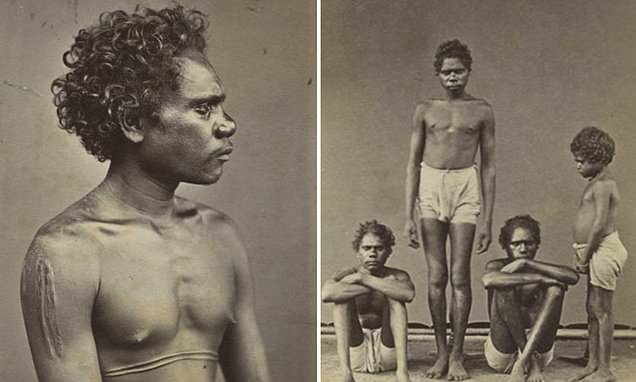By Peter Vincent For Daily Mail Australia
03:15 19 Feb 2023, updated 08:49 19 Feb 2023
- Photo in vault in Rome showed young Aboriginal men living in Indonesia
- Prof. Jane Lydon says the men may have south wives, or even been slaves
- Search underway in Makassar for descendants of Yolngu Aboriginals
A search is underway to find the descendants of a group of young Aboriginals believed to have started new lives in Indonesia more than 150 years ago.
Photos of six Indigenous men and children, taken in Indonesia, were stored in a library in Rome, where they were examined by Perth historian and archaeologist Professor Jane Lydon.
Italian naturalist Odoardo Beccari took the photos between 1860 to 1870 in the Indonesian port city of Makassar, in the Sulawesi region.
One shows three young men staring intently at Mr Beccari’s lens, while a sad looking boy stands side-on clinging to the group.
All are bare-chested, and wearing similar boxer-type shorts.
Another image depicts a young man in profile. It’s taken much closer to the subject and the man’s traditional scarification stands out.
Aboriginal elders who have studied the photos recognise the man’s scarring as the work of Yolngu people and believe the man to be from Arnhem land.
Deliberate scarring was a form of storytelling etched on the body. It has been long practised by the Yolungu people using stone knives.
‘Scarring is like a language inscribed on the body, where each deliberately placed scar tells a story of pain, endurance, identity, status, beauty, courage, sorrow or grief,’ according to the Australian Museum.
There are many accounts of Indonesian fishermen visiting northern Australia for hundreds of years while fishing in Australian waters for Trepang (sea cucumber) and mixing with local Aboriginals.
But experts believe the photos are the best evidence yet corroborating accounts of Aboriginal men returning to Indonesia with fishing boat crews.
Professor Lydon told Daily Mail Australia the images bring that theory to life.
She admits being ‘blown away’ when she first saw the photos in the vaults of the Luigi Pigorini National Museum of Prehistory and Ethnography in Rome.
‘It was a really wonderful moment of discovery. They do open up the imagination, they let us connect with people in the images,’ she said.
‘Maybe they said “can we go back with you work on the ships?”
‘Maybe they thought “I can work in Makassar” and that’s what they did.
‘There are accounts now that say they settled down, married Makassan woman and raised Makassan families and the returned to Arnhem land.’
Some no doubt were driven by the desire to ‘have a woman in every port’, Professor Lydon said.
There’s a possibility the men were slaves.
‘There is some evidence that during late 19th century we know that some men from Kimberly kidnapped and taken to Makassar and enslaved,’ Prof. Lydon said.
‘So it is possible that that maybe just maybe they were taken against their wills.’
Prof. Lydon said the likelihood of Aboriginals living their lives between northern Australia and Indonesia counters a powerful myth that Indigenous people never strayed far from traditional lands.
‘The truth is Aboriginals were great seafarers,’ she said.
This unfamiliar view of Aboriginals as curious about the world is supported by the photographer’s own travel journals.
Mr Beccari, wrote in his travel journal in 1873 that ‘Indigenous Australians are not uncommon in Makassar’.
‘In July and in September at the height of the influx, the harbour teems with boats of every type and size: Chinese, Malays, Indians, Bughis, Papuans, and Australians form a confused jumble of colourful turbans and multi-coloured clothes.’
So far early efforts to find Makassans with Aboriginal heritage have been positive.
Prof. Lydon said said there have been unconfirmed reports so far of Makassans who recognised the scarring on one of the men as the markings on their own relative.
Leading the practical part of the search for the descendants is Makassan-born Indonesian writer, and educator Lily Yulianti Farid, a research fellow at Monash University.
She sees important personal and political dimensions to the search.
‘People try to find their families, and are asking endless questions. ‘Do I have family in Makassar, and how can I reach them?’
It’s also important for these two countries’ relationship — not only are we close neighbours, but we have this shared past and it could help shape our future,’ she told the ABC.
It’s a relationship that has seen differences (cultural and religious) seem more important than similarities (our closest neighbours) especially in the age of national boundaries.
For the last 40 years if Indonesian fishermen are caught crossing the Arafura Sea to fish the west coast of Arnhem land their boats are burned and the fishermen are deported.
But for 400 years before that, Makassars not only fished Arnhem land, they had major impacts on the Yolngu.
Makassars introduced Yolngu to metal, which enabled them to replace traditional bark canoes with sturdier dug-out canoes that would allow for bringing in dugongs or sea turtles.
This enabled some Yolngu communities to transition from land-based economies to sea-based ones.
Makassar they influenced their culture and food, some intermarried and the Indonesians even left an imprint of Islam among the locals.
Muslim references still survive in certain ceremonies and Dreaming stories in the early 21st century.
It is said Yolngu learned of the existence of white people through Makassan traders.
.
